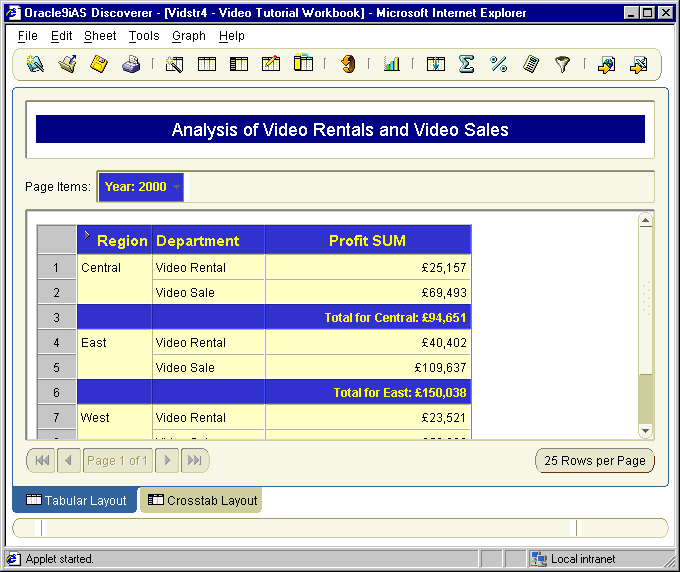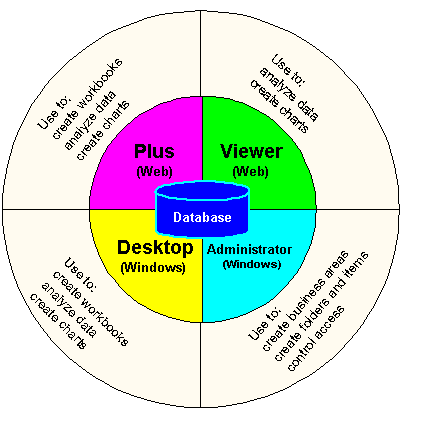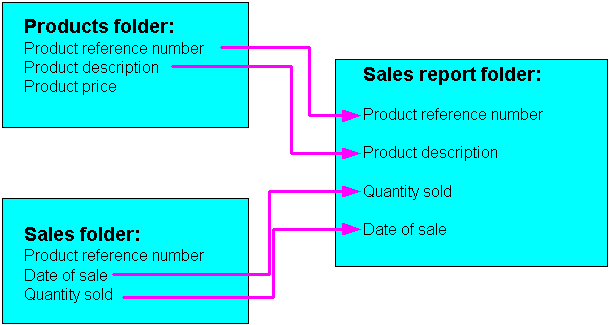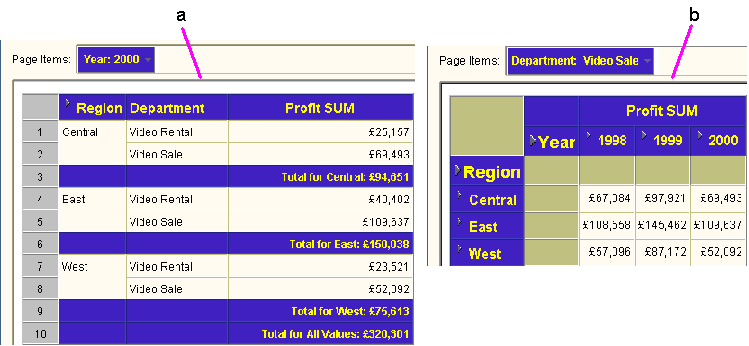Version 9.0.2
Part Number A90879-02
Home | Solution Area | Contents |
Index |
| Oracle9iAS Discoverer Plus User's Guide Version 9.0.2 Part Number A90879-02 |
|
This chapter introduces Discoverer Plus, and includes the following topics:
Discoverer Plus is a business intelligence (BI) analysis tool that works over the Internet.
Discoverer Plus is the Internet version of the award-winning Windows product, Discoverer Desktop. If you are already familiar with Discoverer Desktop, you will recognize many Discoverer Plus features. The two versions are compatible and you can share work between them. The figure below shows the Discoverer Plus main screen, with a table worksheet displayed in the work area that analyzes video store profit figures across geographical regions.
For more information about using the Video Stores sample workbooks that are installed with Discoverer, contact the Discoverer manager.

Using Discoverer, you can access and analyze data that you know is in your company's database, without having to understand complex database concepts. Using Wizard dialogs and menus, Discoverer guides you through the steps to get and analyze data that supports your business decisions. Discoverer does the hard work for you.
The figure below shows how Discoverer Plus fits into the Oracle9iAS family of Business Intelligence products.

Discoverer Plus version 9.0.2 contains the following new and improved features:
Discoverer's powerful and intuitive user interface enables you to:
Discoverer uses a unique way of accessing data. Comparing Discoverer with other ways of accessing data that you might have used will help you understand why Discoverer is so powerful.
Imagine that you want to analyze information in a database.
In the past you typically had to:
With Discoverer, you simply open a workbook containing the data you want to see and start analyzing. You do not have to know anything about databases. You do not have to want a long time to get information. You do not have to use another application to analyze your data.
When working with Discoverer, you use business areas, folders, and items (see figure below).

Key to figure:
A business area is a collection of related information in the database. The Discoverer manager works with the different departments in your organization to identify the information that each department requires from the database. The Discoverer manager locates the information in the database and groups it into business areas. For example, a company's business areas might be budgets, finance, and projects. The Discoverer manager also decides which users can access which business areas.
Within each business area, the Discoverer manager organizes information into folders. A folder is a collection of closely related information. For example, information about products that your company produces (e.g. reference number, description, product price) might be in a folder called Products.
The different folders in a business area might contain related information. For example, a business area might contain both a Product folder and a Sales folder. The Sales folder contains information about the sales of each product (e.g. the product reference number, when the product was sold, the quantity that was sold). If you wanted to see a description of a product and when it was sold, you would need information from both the Products folder and the Sales folder. The figure below illustrates how information from both the Products folder and the Sales folder is combined to create a folder called Sales Report. The Sales Report might be used to create workbooks for product analysts who want to analyze sales.

Items are different types of information within a folder. For example, if a Products folder contains reference numbers, descriptions, and the price of each product, the items in the Products folder are reference number, description, and price.
Each item contains individual pieces of information. For example, the reference number item might contain a list of reference numbers.
The Discoverer manager decides which items are included in folders based on the information that you want to analyze.
If you are familiar with databases:
The Discoverer manager is the person in your organization that is responsible for setting up and maintaining Discoverer. The Discoverer manager uses the Discoverer Administrator tool to:
In some organizations, the Discoverer manager also creates predefined workbooks for Discoverer users.
Discoverer is supplied with an example database called Video Stores Tutorial. The Video Stores Tutorial contains data about a fictitious video store business. Information stored in the Video Stores Tutorial includes:
Discoverer is also supplied with a sample workbook called Video Tutorial Workbook that you can use to analyze the example data. The Video Tutorial Workbook contains two worksheets:
Note: The Discoverer manager might have given the sample workbook a different name from Video Tutorial Workbook.
Both worksheets enable you to analyze the profitability of the video store business (see figure below).

Key to figure:
A worksheet contains a report that you have created (for more information, see "What are worksheets?").
A workbook is a collection of worksheets, (for more information, see "What are workbooks?")
A query is a search of the database that finds and retrieves the data you want to analyze. Each worksheet in a workbook contains the result of a query. When you see the term "query" while working with Discoverer Plus, think of it as a worksheet containing retrieved data. For more information about SQL and queries, see "What is SQL".
As you become more familiar with Discoverer, you will find a workflow that suits you best. Typically, using Discoverer is a three-stage process:
When working with Discoverer, you get the data you want by:
Your ultimate goal in using Discoverer is to analyze your business and arrive at a profitable business decision. To do this, you might ask yourself questions about your business. For example:
With Discoverer's data analysis tools, you can find the answers to these and other business questions by:
The end result is a collection of worksheets and graphs that persuasively supports your business decisions.
Once you have retrieved and analyzed data, you will probably want to share your results with other people at your organization, with customers, or with business partners.
If these people also have Discoverer, you can share your workbooks and worksheets with them. You can store your workbooks in the database and schedule them to update at regular intervals.
If these people do not have Discoverer, you can publish your reports in popular application formats (e.g. Microsoft Excel, HTML).
The Discoverer Plus Help System gives you context sensitive access to reference information from the Discoverer Plus User's Guide in HTML format.
To start the Help System either click Help in a Discoverer dialog or choose Help | Help Topics.
To find a topic in the Help System:
To view (and print) the Discoverer Plus User's Guide in PDF format, use the Oracle9iAS documentation CD.
Hint: To search for words or phrases, use the Discoverer Plus User's Guide in PDF format.
|
|
 Copyright © 2002 Oracle Corporation. All Rights Reserved. |
|